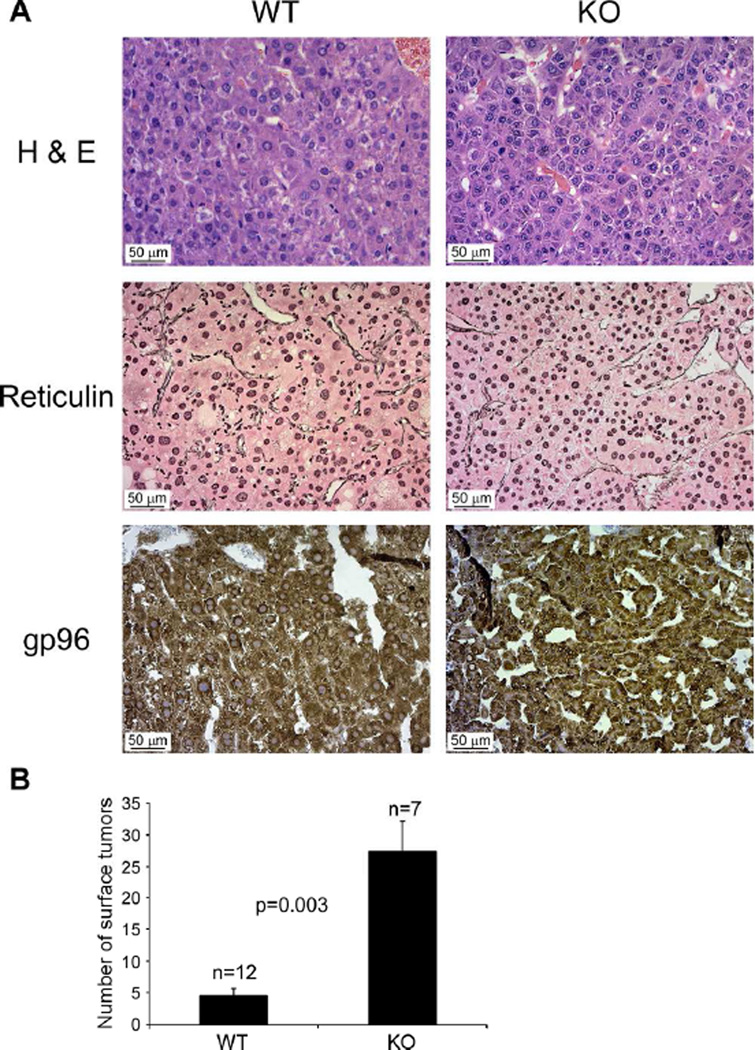To the Editor
We read with great interest the article by Chen et al. published in Hepatology (1). gp96, or grp94, is an endoplasmic reticulum (ER) HSP90 that chaperones many strategically important clienteles in oncogenesis including integrin, Toll-like receptor, Wnt co-receptor and insulin-like growth factor. However, Chen et al. demonstrated that conditional deletion of hsp90b1 (encoding gp96) and Pten from mouse livers using Cre recombinase driven by Albumin promoter (Alb-Cre) increased liver tumorigenesis (1). Nevertheless, the gp96 status of these tumors was not reported, leaving open a possibility of gp96 being either a tumor suppressor (if tumors were gp96−) or a pro-oncogenic chaperone (if gp96+). This diametrically opposing viewpoint is important to clarify particularly because liver-specific knockout of pro-tumorigenic genes could result in paradoxical enhancement of tumorigenesis from cells that escaped cre-mediated deletion (2). Herein, by crossing the same Alb-cre mice with our independently generated hsp90b1flox/flox mice (3, 4), we also probed the roles of gp96 in liver oncogenesis. We found that knockout (KO) mice were more susceptible to hepatocyte carcinogenesis than wild type (WT) mice in response to diethyl-nitrosoamine (DENA), but the developing tumors were exclusively gp96+, due to an age-dependent expansion of the residual WT hepatocytes (Figure 1).
Figure 1. Alb-cre-gp96flox/flox mice (KO) have increased liver carcinogenesis from residual gp96+ hepatocytes.
(A) Representative images of WT and KO tumors. (B) Quantification of liver tumors from WT and KO mice 62 weeks post DENA injection.
The development of gp96+ but not gp96− tumors in the same hosts illustrated its tumor-promoting rather than tumor-suppressive role. It might be prudent to examine if the Pten-loss tumors in the study of Chen et al. were also gp96+, analogous to another study on ER chaperone grp78 (5). It was found that liver cancer develops from escaping residual grp78+ hepatocytes after intended biallelic liver-specific deletion of Pten and grp78 via Albumin-Cre. The shared but apparently non-redundant cellular function of grp78 and gp96 in liver cancer underscores the critical oncogenic roles of both chaperones.
References
- 1.Chen WT, Tseng CC, Pfaffenbach K, Kanel G, Luo B, Stiles BL, Lee AS. Liver-specific knockout of GRP94 in mice disrupts cell adhesion, activates liver progenitor cells, and accelerates liver tumorigenesis. Hepatology. 2014;59:947–957. doi: 10.1002/hep.26711. [DOI] [PMC free article] [PubMed] [Google Scholar]
- 2.Sekine S, Ogawa R, Kanai Y. Hepatomas with activating Ctnnb1 mutations in 'Ctnnb1-deficient' livers: a tricky aspect of a conditional knockout mouse model. Carcinogenesis. 2011;32:622–628. doi: 10.1093/carcin/bgr002. [DOI] [PubMed] [Google Scholar]
- 3.Yang Y, Liu B, Dai J, Srivastava PK, Zammit DJ, Lefrancois L, Li Z. Heat shock protein gp96 is a master chaperone for toll-like receptors and is important in the innate function of macrophages. Immunity. 2007;26:215–226. doi: 10.1016/j.immuni.2006.12.005. [DOI] [PMC free article] [PubMed] [Google Scholar]
- 4.Staron M, Yang Y, Liu B, Li J, Shen Y, Zuniga-Pflucker JC, Aguila HL, et al. gp96, an endoplasmic reticulum master chaperone for integrins and Toll-like receptors, selectively regulates early T and B lymphopoiesis. Blood. 2010;115:2380–2390. doi: 10.1182/blood-2009-07-233031. [DOI] [PMC free article] [PubMed] [Google Scholar]
- 5.Chen WT, Zhu G, Pfaffenbach K, Kanel G, Stiles B, Lee AS. GRP78 as a regulator of liver steatosis and cancer progression mediated by loss of the tumor suppressor PTEN. Oncogene. 2013 doi: 10.1038/onc.2013.437. [DOI] [PMC free article] [PubMed] [Google Scholar]



